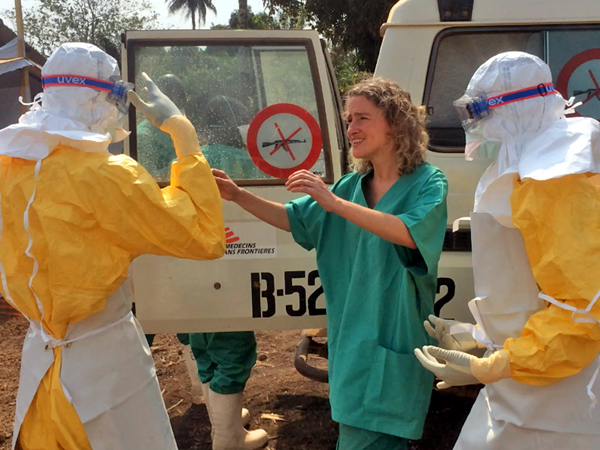
In this photo provide by MSF, Medecins Sans Frontieres (Doctors without Borders), taken on Friday, March 28, 2014, healthcare workers from the organisation, react, as they prepare isolation and treatment areas for their Ebola, hemorrhagic fever operations, in Gueckedou, Guinea. Health officials in the West African nation of Guinea say they’re now treating eight cases of Ebola in the capital. Dr. Sakoba Keita, a spokesman for the health ministry, announced on national television the virus had reached the city of 3 million. Keita said Friday, March 28, 2014, at least 70 people have died in the country’s south since the Ebola outbreak began last week. AP
MANILA, Philippines—There is no need to impose a ban on travel to countries where outbreaks of the ebola virus have been reported, according to the World Health Organization.
The international health agency said there was not enough reason to push for the imposition of travel restrictions in response to the Ebola outbreak.
“WHO does not recommend that any travel or trade restrictions be applied with respect to this event,” it said in a statement.
In the Philippines, the Department of Health likewise does not see any need to issue a travel advisory regarding countries where there is an outbreak of the disease.
“Travelers have very low risk,” said DOH-National Epidemiology Center head Dr. Eric Tayag in his Twitter account (@erictayagSays).
But Tayag said that while the Ebola virus is not known to spread via global travel, the DOH was still monitoring and screening for fever among travelers arriving in airports.
The WHO also urged countries to reinforce their surveillance activities over the possible entry of the Ebola virus.
“WHO encourages countries to strengthen surveillance, including surveillance for illness compatible with EVD, and to carefully review any unusual patterns, in order to ensure identification and reporting of human infections,” it said.
Late last month, Guinea health authorities declared a health emergency after seeing a sharp rise in the number of Ebola cases.
Similarly, Liberia admitted the presence of an epidemic in the country from the Ebola virus disease.
According to the WHO, fruit bats are believed to be the natural hosts of the Ebola virus which can be transmitted from wildlife to people through contact with infected fruit bats, or through intermediate hosts like monkeys, apes, or pigs that become infected through contact with bat saliva or feces.
Ebola is a severe acute viral illness often characterized by the sudden onset of fever, intense weakness, muscle pain, headache, nausea and sore throat followed by vomiting, diarrhea, impaired kidney and liver function, and in some cases, both internal and external bleeding.

